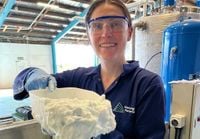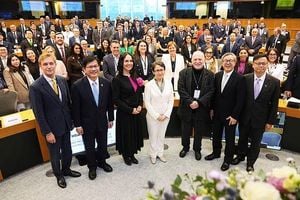In a world increasingly reliant on advanced batteries for electric vehicles, renewable energy storage, and everyday devices, the scramble for critical minerals has never been more intense. Yet, as countries and companies chase these resources, a pair of stories from the Asia-Pacific region reveal a new chapter unfolding—one that could reshape both how raw materials are processed and who reaps the rewards.
Downstreaming, the process of adding value to raw materials through refining, processing, and manufacturing rather than simply exporting them, has become a rallying cry for resource-rich nations. The promise is clear: more jobs, technology transfer, and a stronger voice in global value chains. But as the experience of several countries shows, the journey from ambition to achievement is anything but simple.
According to the Lowy Institute, many nations in Asia and the Pacific are now pursuing downstreaming strategies. The Solomon Islands, for example, has recently announced plans to add value to its logging and fisheries sectors. This effort is part of its broader strategy to graduate from Least Developed Country status. Papua New Guinea is also getting in on the act, with a focus on downstream processing for its tuna industry. The hope? To move beyond being mere suppliers of raw materials and instead become creators of value—generating skilled jobs, diversifying their economies, and building resilience against the wild price swings that often buffet commodity markets.
But there’s a catch: as the Lowy Institute points out, having raw materials doesn’t guarantee that local processing is the best—or even a viable—option. Take Australia, for example. Despite being one of the world’s mineral powerhouses, it exports most of its minerals because the economics simply make more sense. On the flip side, Singapore, with virtually no natural resources, has built a thriving economy by focusing on finance, logistics, and innovation, letting these sectors outpace traditional manufacturing.
For those determined to pursue downstreaming, the OECD framework for industrial policy offers a roadmap. Success depends not just on bold policy, but on strong institutions, long-term planning, and the flexibility to adapt when things change. It requires clear mandates, accountable governance, and effective coordination between sectors, levels of government, and private industry. Without these, even the best-laid plans can unravel.
Indonesia’s experience with nickel downstreaming offers a cautionary tale. The country has attracted significant foreign investment and built processing plants, but not without cost. Environmental damage, labor issues, and governance challenges have all surfaced. And while Indonesia’s efforts have relied heavily on Chinese capital, technology, and market access, the benefits for local communities have been limited. As the Lowy Institute notes, Chinese firms have reaped most of the rewards, enjoying tax holidays, cheap domestic nickel ore, and subsidized coal-based energy. If Indonesia is to truly benefit, it must refine its strategy—boosting competitiveness, reducing reliance on China, and strengthening environmental, social, and governance standards.
So, what’s the first step for any country considering downstreaming? According to the Lowy Institute, governments must honestly assess their competitive advantage and readiness. Why haven’t downstream industries developed organically, even with abundant raw materials? If a sector lacks a genuine economic edge, forcing it could waste resources or even cause harm. But if the main barriers are access to finance, technology, or skills, targeted policies might help overcome them. Market relevance is also key: understanding real demand, meeting strict standards, and securing off-take agreements with buyers in markets like the European Union, United States, China, or Australia is crucial.
Collaboration, too, can make a difference. By working with other countries, governments can strengthen their position in supply chains, share capabilities, and reduce risks. But all of this hinges on smart policy design. Downstreaming isn’t just about minerals in the ground—it demands significant upfront investment, advanced technology, skilled labor, and increasingly, clean energy. As global standards for low-carbon supply chains rise, compliance is no longer optional. Governments must craft targeted policies to overcome these constraints and ensure they keep pace with evolving requirements.
Implementation, of course, is where the rubber meets the road. Political stability, transparency, and strong regulation are essential to turn policy into reality. Weak enforcement or opaque licensing can scare off investors and erode public trust. And without rigorous environmental, social, and governance standards, countries risk losing access to premium markets or damaging their reputations—potentially stalling future investment.
Yet, even as these debates unfold, a startup in New Zealand is quietly rewriting the rules of the game. On August 15, 2025, Good News Network reported that Aspiring Materials, a Christchurch-based venture, has developed a chemical process to extract critical battery minerals from olivine—a mineral typically considered waste in mining operations. This new approach could have far-reaching implications for both supply chains and sustainability.
Olivine, once mostly used as gravel or in niche applications like sauna rocks, contains nickel-manganese-cobalt hydroxide (NMH)—a key ingredient in high-density lithium-ion batteries. These batteries power everything from electric vehicles to energy storage solutions. Traditionally, cobalt is mined in the Democratic Republic of the Congo, nickel in Indonesia, and manganese in South Africa—most of which is then shipped to China for refinement. This concentration has raised alarms in Western countries worried about supply security and the ethical, environmental, and geopolitical risks tied to these minerals.
Enter Aspiring Materials’ innovation: they use a low-temperature, ambient pressure process powered by renewable energy to leach NMH from olivine sand. Their pilot plant in Christchurch mixes olivine with sulfuric acid, creating a sticky soup of elements. Several steps later, with a bit of caustic soda, the process yields three products: 50% becomes an analog to Portland cement (the world’s most common building material), 40% turns into a valuable magnesium product, and 10% is a mixed metal product—of which 1% is the sought-after NMH. What’s left is funneled through electrolysis to regenerate the acid, making the entire operation a neat, circular production method.
This approach doesn’t just make use of what was once considered waste—it also addresses some of the most pressing concerns in the battery supply chain. As Jim Goddin, a UK expert on critical minerals, told Spectrum, “While the high-acidic environment needed to extract NMH from olivine might result in a higher-cost end product, Western markets are progressively seeing cleaner production methods as worth the extra cost in the face of potential negative press from organizations that conduct reviews on sustainability.”
Cleaner, more circular methods are gaining traction as governments and companies seek to reduce their environmental footprint and insulate themselves from reputational risks. And while the economics may not always favor such innovations in the short term, the long-term benefits—greater supply security, reduced environmental impact, and stronger local economies—are hard to ignore.
Both the push for downstreaming in the Pacific and the innovation unfolding in New Zealand underscore a broader shift: the old model of simply digging up resources and shipping them abroad is being challenged. Whether through bold national strategies or clever new technologies, the value of raw materials is increasingly being realized closer to home, with the potential to transform economies and communities alike.
The road ahead won’t be easy, but as these stories show, it’s one worth traveling for those willing to invest in the future—and in themselves.




